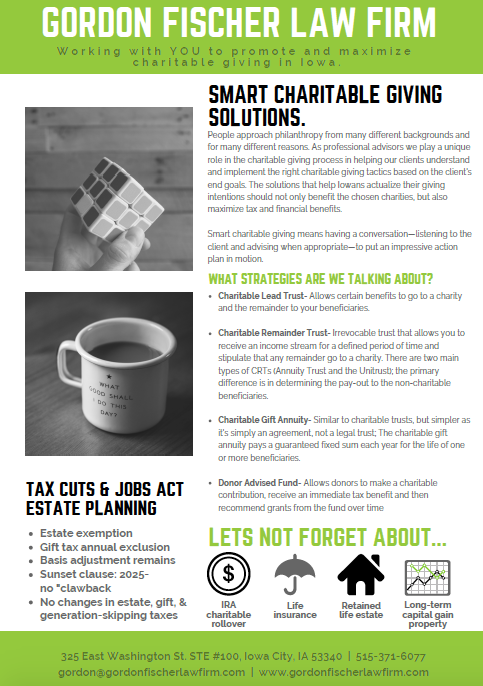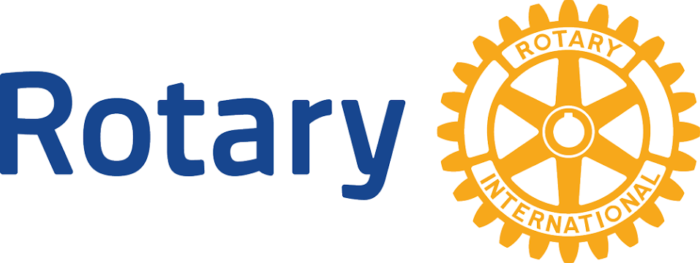I’m proud to be an active Rotarian. I’m also proud to be an Iowa lawyer.
And, I am proud of the singular, perhaps even unique, mission of my law firm. The mission of Gordon Fischer Law Firm is to promote and maximize charitable giving in Iowa.

To achieve this mission, I help individuals, families, and businesses with estate planning that ranges from simple wills to complex trusts. I assist nonprofits reach their philanthropic goals. I guide donors in increasing their charitable giving.
Naturally, my membership in Rotary and the mission of my law firm intersect perfectly when it comes to supporting the Rotary Foundation. The Rotary Foundation does so much good both here at home and around the world.
As the Rotary Foundation states on its website, the Foundation “taps into a global network of Rotarians who invest their time, money, and expertise into our priorities, such as eradicating polio and promoting peace. The Foundation grants empower Rotarians to approach challenges such as poverty, illiteracy, and malnutrition with sustainable solutions that leave a lasting impact.”

As a Rotarian, and as a lawyer, I wanted to share some of my expertise to allow Rotarians to give even more generously, so the Rotary Foundation can continue to do, and perhaps even expand, their great work.
TYPES OF CHARITABLE GIVING
It’s easiest to understand charitable giving by looking at it in two broad categories: giving during lifetime (called inter vivos transfers), and giving at death (testamentary transfers). There is a third category which lawyers call “split interest gifts”—tools that can be used during life or by operation of a will (such as, charitable gift annuities and charitable remainder trusts).
Read on to learn more about testamentary gifts made through your estate plan. Then we’ll talk about charitable giving during your lifetime. Finally, we’ll discuss two special philanthropic tools that can both be used during life and at death.
CHARITABLE GIVING THROUGH YOUR ESTATE PLAN

Estate plan is set of legal documents
An estate plan is simply a set of legal documents to prepare for the event of your death or disability. Note I said “estate plan,” and not “will.” While these terms are often used synonymously, they are not at all the same thing. An estate plan is a set of legal documents, and a will is just one of those documents, albeit an important one.
Six “Must Have” Estate Planning Documents
There are six documents that should be part of most everyone’s estate plan. Plus, you should keep these documents updated and current. Also, don’t forget about assets with beneficiary designations, such as savings and checking accounts, and retirement benefit plans. For many Iowans, that’s enough— keeping six documents and assets with beneficiary designations current.
I’ll just briefly touch on five of the six documents, before we dive into your will and charitable gifting to the Rotary Foundation.
Estate Planning Questionnaire
You should begin with an estate planning questionnaire. (Like this one on my website.) An estate plan questionnaire is an easy way to get all of your information in one place, and it should help you understand and prioritize estate planning goals.
Powers of Attorney
A power of attorney for healthcare designates someone to handle your healthcare decisions for you if you become unable to make those decisions for yourself. This essentially gives another person the power to make medical decisions on your behalf.
The power of attorney for financial matters is similar, only your designated agent has the power to make decisions and act on your behalf regarding your finances. This document gives your agent the authority to pay bills, settle debts, sell property, or anything else that needs to be done if you become incapacitated and unable to do this yourself.
Disposition of Personal Property
Another useful document is the disposition of personal property. This is where you get to be specific about items you want people to have, say, your eldest daughter getting your wedding ring, or your nephew getting your baseball card collection.
Disposition of Final Remains
Yet another helpful document is the disposition of final remains, where you get to tell your loved ones exactly how you want your body to be treated after you pass away. This could include details on burial or cremation, and what type of service(s) you want.
Where there’s a Will, There’s A Way to Help Rotary Foundation
Now let’s get to the will. With your will, you’ll be answering four major questions:
- Who do you want to have your stuff? A will provides orderly distribution of your property at death per your wishes. Your property includes both tangible and intangible things. (An example of tangible items would be your coin collection. An example of an intangible asset would be stocks.)
- Who do you want to be in charge of carrying out your wishes as expressed in the will? The “executor” is the person who will be responsible for making sure the will is carried out as written.
- Who do you want to take care of your kids? If you have minor children (i.e., kids under age 18), you’ll want to designate a legal guardian(s) who will take care of your children until they are adults.
- What charities do you want to support with your estate assets? Which of your favorite causes do you want to support at death, like the Rotary Foundation?
Four Types of Bequests
Charitable gifts in a will are called “bequests.” Generally speaking, there are four types of bequests.
- Pecuniary Bequest: A gift of a fixed or stated sum of money designated in a donor’s will. An example: “I give the sum of $10,000 (ten thousand dollars) to Rotary Foundation.”
- Specific Bequest: A gift of a designated or specific item in the will. The item will most likely be sold by the organization and the proceeds would benefit that nonprofit. An example: “I give my Grant Wood painting to Rotary Foundation.”
- Residuary Bequest: In legal terms, a “residue” of the estate is what is left of the estate after payment of debts, funeral expenses, executors’ fees, taxes, legal, and other expenses incurred in the administration of the estate, and after any gifts of specific assets or specific sums of cash. The estate residue would include all property, both personal and real estate. A residuary clause is a provision in a will that passes the residue of an estate to beneficiaries identified in the will. An example: “I give all of the residue of my estate to the Rotary Foundation.”
- Contingent Bequest: A gift in a will made on the condition of a certain event that might or might not happen. A contingent bequest is specific and fails if the condition is not made. An example: “I give the sum of $10,000 (ten thousand dollars) to my niece, Jane Smith, if still living. If my niece fails to survive me, I give the sum of $10,000 (ten thousand dollars) to the Rotary Foundation.”
Which type of bequest to the Rotary Foundation should you choose? It really depends on your personal circumstances. Consult your individual estate planner for specific advice.
CHARITABLE GIVING DURING LIFETIME
It’s been said, “you should be giving while you are living, so you’re knowing where it’s going.” Many Rotarians have intentions to donate eventually to the Rotary Foundation, often, as we’ve been discussing, at death through their estate plan. But why not give now? You can have more say about your gifts while you are still alive, and also feel the joy that comes with helping the cause you care about most. There are also lots of good tax reasons for giving now rather than later.
Imagine Rotarian Jill Donor, wanting to help her favorite nonprofit. When asked for a charitable gift to the Rotary Foundation, Donor agrees and immediately reaches for her checkbook, or goes online to donate with a debit/credit card.
It’s noble for Donor to give. However, consider this question: should Donor give cash? Or, does Donor own other non-cash assets which might be more tax-savvy? Can Donor be even more generous in support of her favorite cause, while lowering her out-of-pocket costs for charitable gifts?
Also, keep in mind that cash is only a small sliver of Donor’s overall assets and net worth. Even putting aside tax benefits, couldn’t Donor give more to the Rotary Foundation by looking at her much more robust non-cash assets? Let’s explore some non-cash gift options.

Appreciated, Long Term, Publicly Traded Stock
All sorts of non-cash assets can be used for charitable gifts to the Rotary Foundation, but for several reasons, appreciated, long-term, publicly traded stock is a wise choice. It’s convenient to give, you can save money on capital gains taxes you would have paid had you sold the stock, and it’s easy to value.
Endow Iowa Tax Credit
All Iowans should be aware of the Endow Iowa Tax Credit. Endow Iowa allows donors who give qualifying charitable gifts to receive a whopping 25% state tax credit. I have some illustrations showing what great tax savings can be realized by use of the Endow Iowa Tax Credit.
IRA Charitable Rollover
The federal law known as the IRA Charitable Rollover allows individuals aged 70½ and older to donate up to $100,000, tax free, from their IRAs directly to Rotary Foundation. There are two threshold requirements. First, you must be age 70½ or older. Second, the retirement plan account must be an IRA. Want more details? This blog post digs in.
Retirement Benefit Plans
For those not yet 70 ½ and/or who don’t have an IRA, but another type of retirement plan, think about this. Sometimes owners’ retirement benefit plans must make what are called Required Minimum Distributions, or RMDs. Since you must withdraw RMDs, anyway, why not give the money to a worthy charity like Rotary Foundation?
For those who don’t yet have to make RMDs, remember that after age 59 ½, generally you can make withdrawals from your retirement benefit plan without any tax penalty. If indeed there’s no penalty, and you make a charitable gift from your retirement benefit plan, you can presumably take an income tax charitable deduction. This should therefore be a “wash” for tax purposes.
Also, keep in mind: you can make a very meaningful gift simply by naming the Rotary Foundation as beneficiary of an IRA, 401(k), 403(b), or other retirement plan. Giving retirement assets in this way is quite easy. Simply contact the institution holding your retirement plan, request a change of beneficiary form, fill the form out completely and correctly, and return the form. Typically naming a beneficiary in this way does not require drafting or amending a will or trust.
“SPLIT INTEREST” GIFTS
A “split interest” gift is when a donor makes a gift to a qualified charity, like the Rotary Foundation, but retains the right to a portion of the gift. Typically, the gift is divided into lifetime income and asset value at death. The majority of donors retain income during their lifetime.
There are two split interest gifts which might be greatly helpful to donors wanting to support the Rotary Foundation. Let’s discuss each briefly.
Charitable Gift Annuity
A Charitable Gift Annuity (CGA) is a contract. It’s a contract that combines the benefits of an immediate income tax deduction and a lifetime income stream. Also, your future taxable estate will be reduced for the remainder value of the property transferred to charity.
A CGA is an arrangement in which you make a gift of cash, or other property, in exchange for a guaranteed income annuity for life. This is similar to buying an annuity in the commercial marketplace, except that you can claim an immediate charitable tax deduction for the excess of the value of the property over the value of the annuity, based on IRS tables. The charity must receive at least 10% of the initial net value of the property transferred in order for you to claim a charitable deduction for a portion of the purchase price.
There’s much more to say about CGAs. I wrote an article detailing more specifics, as well as their benefit, check it out here.
Charitable Remainder Trust
A charitable remainder trust (CRT) provides a unique opportunity for donors to retain lifetime income from property while obtaining a current income tax deduction (or estate tax deduction) for the remainder interest which will pass to charity.
Charitable remainder trusts are often appealing to donors with appreciated assets, producing little or no income, such as real estate or securities. This is because the assets can be sold without capital gains tax and invested to provide a higher income stream.
A CRT separates the current interest and future interests in property and disposes of each differently. Income from trust assets is paid to at least one non-charitable beneficiary (often, the grantor or the grantor’s family) for a certain period. The payments can be made for the non-charitable beneficiary’s lifetime (or joint lives for multiple beneficiaries), or over a fixed period of up to 20 years. When the non-charitable beneficiary’s interest ends, the trust assets pass irrevocably to a charity. I’m doing a deep dive into CRTs with a three-part series, you can read the first post, here.
SUM IT ALL UP

What all this means is that you, dedicated Rotarian, have a treasure chest of choices when it comes to making charitable gifts that can have an impact. Charitable giving can, and should, be a mutual positive situation that benefits the Rotary Foundation as well as the donor. Of course, this is just the tip of the iceberg. I would love to start a conversation with you about your estate planning and charitable giving goals. Feel free to reach out at any time; you can find me by email at Gordon@gordonfischerlawfirm.com or by phone at 515-371-6077. Or just grab me at Rotary Lunch!
Gordon Fischer has been an active and accomplished Iowa lawyer for more than 20 years. Gordon received his law degree, summa cum laude, from Southern Illinois University. After law school, Gordon clerked for the Iowa Court of Appeals. He then joined the Des Moines firm of Bradshaw, Fowler, Proctor & Fairgrave, P.C. He became a partner and gained a reputation for skilled and conscientious litigation in all areas of law, with a focus on employment. In 2013, Gordon left the firm to become Vice President of Gift Planning Strategies for the Community Foundation of Greater Des Moines, where he helped donors plan and achieve their philanthropic goals. In 2014, he received the Chartered Advisor in Philanthropy designation from The American College of Financial Services.
Gordon serves his community and his profession in a variety of ways, on boards and commissions and as a mentor and hands-on volunteer, and through his involvement as a Rotarian. At Gordon Fischer Law Firm, P.C., he blends his legal expertise and commitment to the charitable sector and those who support its work.











